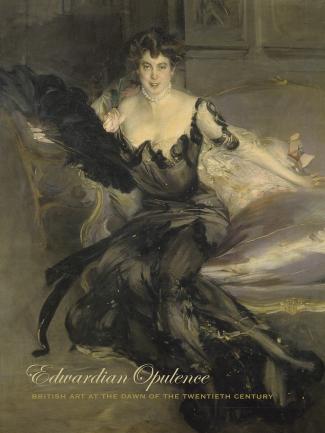Edwardian Opulence: British Art at the Dawn of the Twentieth Century was the first survey in more than a generation of the full extent, breadth, and depth of the visual arts in Britain during the reign of King Edward VII (1901–10). Among other themes, the exhibition explored the pan-imperial, international, and transatlantic character of British art in that complex period, and considered the impact of new technologies—such as electrification, the motor car, recorded sound, and cinema—on painting, sculpture, photography, and the decorative arts. Many of the objects in the exhibition were chosen to reveal the full and often startling magnificence of elite consumption during that turbulent decade. The emphasis on the theme of opulence served to illuminate a social and artistic dreamscape that was shattered by World War I.
Recently made popular by the British television series Downton Abbey, the Edwardian period has been depicted as an indolent summer afternoon of imperial and elite complacency, a lingering coda of the Victorian era that resisted the advent of the Modern, but also as a period of tremendous and rapid political, economic, and artistic change that affected every aspect of British life. Edwardian Opulence explored issues of creation, consumption, and display through a range of objects, including portraits by John Singer Sargent and Giovanni Boldini, diamond tiaras and ostrich-feather fans, jewel-like Autochrome color photography, and a spectacular embroidered gown that belonged to the American-born Vicereine of India. Spanning divides of class and geography, the exhibition identified opulence and leisure as driving forces for the domestic and imperial British economic engine in the early years of the twentieth century.
Among the lenders to Edwardian Opulence were public art museums and private individuals spread over four continents. These included Her Majesty Queen Elizabeth II, His Grace the Duke of Devonshire, the Right Hon. Lord Rothschild, the British Museum, the Victoria and Albert Museum, Tate Britain, the Royal Academy of Arts, the Metropolitan Museum of Art, the Musée d’Orsay, the Collection Cartier in Geneva, the South African National Gallery in Cape Town, the Johannesburg Art Gallery, the National Gallery of Victoria, the Art Gallery of New South Wales, and many others.
The exhibition included a special program of historic sound recordings that were selected from the Yale Collection of Historical Sound Recordings in the Irving S. Gilmore Music Library at Sterling Memorial Library. Some of the recordings related directly to works on display in the exhibition, but the majority were selected with broader themes in mind, such as patriotism, politics, memory, language, sentiment, and a peculiarly Edwardian sense of wistful nostalgia.
View works from the collection included in this exhibition here.
Credits
Edwardian Opulence: British Art at the Dawn of the Twentieth Century was organized by the Center and curated by Angus Trumble, Senior Curator of Paintings and Sculpture, and Andrea Wolk Rager, Visiting Assistant Professor, Case Western Reserve University. The exhibition was accompanied by a major publication, edited by the curators and published by the Center in association with Yale University Press.
Top image
Edwardian Opulence: British Art at the Dawn of the Twentieth Century installation, Yale Center for British Art, photo by Richard Caspole
Extended reading

Edwardian Opulence: British Art at the Dawn of the Twentieth Century
Edited by Angus Trumble and Andrea Wolk Rager